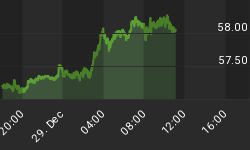Below is a slightly-modified excerpt from a commentary originally posted at www.speculative-investor.com on 14th December 2014. Also, excerpts from our newsletters and other comments on the markets can be read at our blog: http://tsi-blog.com/
The conventional view is that Fed money creation is necessarily bullish for gold and that a tightening of monetary conditions beginning with the cessation of Fed money creation is necessarily bearish for gold. It's strange that this view is popular given that gold was clearly hurt more than helped by the QE program that extended from October of 2012 through to October of this year. If gold is now going to be hurt by a 'tighter' Fed, the implication is that regardless of what the Fed does it's bearish for gold. If the Fed aggressively pumps money into the economy, it's bearish for gold. If the Fed stops pumping money, it's bearish for gold. If the Fed not only stops pumping money but starts hiking interest rates, it's astronomically bearish for gold! Rather than relying on conventional wisdom, which is usually wrong when applied to the gold market, we'll now turn to some historical data in an effort to understand how gold will likely react to a less 'accommodative' Federal Reserve.
First, some data from the distant past.
The following charts show the US$ gold price from January-1977 through to the end of 1979 and the annual rate of change in US TMS (True Money Supply) over the same period. These charts tell us that US monetary conditions became progressively tighter throughout the huge 3-year gold rally of 1977-1979 and that the biggest gains in the gold price occurred in 1979 -- when the US was experiencing monetary DEFLATION. In fact, during no 12-month period over the past 60 years were US monetary conditions tighter than they were throughout 1979 and during no other year did the gold price rise by as much as it did in 1979.
This doesn't imply that tighter monetary conditions are bullish for gold. It implies that under certain conditions gold is quite capable of making large gains in parallel with a tighter Fed.

Next, some data from the recent past.
The Fed announced the beginning of its QE "tapering" on 18th December 2013. The following charts show that within a few days of this announcement gold made a major bottom in non-US$ terms (the gold/UDN ratio is an indicator of gold's performance in terms of a basket of important currencies excluding the US$) and an intermediate-term bottom in US$ terms.
The Fed then methodically "tapered" its QE program during 2014 and announced the completion of the program on 29th October. The following charts also show that within a few days of this announcement gold made short-term bottoms in both non-US$ terms and US$ terms. It's distinctly possible that these short-term bottoms will turn out to have longer-term significance, with the early-November bottom in gold/UDN potentially marking the end of the first correction in a new bull market and the early-November bottom in the US$ gold price potentially marking the end of the cyclical bear market.


The critical point to understand is that gold's perceived value moves in the opposite direction to confidence in central banking and the economy. During periods when a general belief takes hold that the central bank's money-pumping is improving the economy's prospects, the money-pumping turns out to be an intermediate-term bearish influence on the gold market. However, the money-pumping distorts the economy in a way that eventually leads to substantial economic weakness.
A tightening of monetary conditions will begin to reveal the distortions (mal-investments) caused by the preceding 'monetary accommodation', which is why the demand for gold will sometimes increase as the Fed becomes more restrictive. In such a situation gold isn't gaining ground because the Fed is tightening, it is gaining ground because tighter monetary conditions are shining a light on the economic damage caused by the earlier money-pumping.
In simpler terms, gold gets hurt by the boom and helped by the bust, so anything that perpetuates the boom is bearish for gold and anything that helps bring on the bust that inevitably follows an inflation-fueled boom is bullish for gold.
Samples of our work (excerpts from our regular commentaries) and additional thoughts on the financial markets (and other stuff) are provided at our blog: http://tsi-blog.com/
















